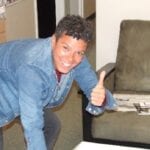After writing his name in capital letters on my cheat sheet of questions, Salvador Ramirez Perez begins to explain why he changed his mind about being an anonymous interviewee, but his emotions temporarily snatch the words from his throat.
“I shouldn’t have no fear,” he eventually — tearfully — blurts out.
“I shouldn’t . . .”
Revealing his name is proof that he is part of the community, he asserts, something he felt he couldn’t fully be as a gay man in his native Mexico, where he was physically attacked several times, or later in the United States, where he made an unsuccessful bid to start a new life.
“Mexico is supposed to be okay, but it is not really okay,” says Ramirez Perez, who left his country in 1989. “There’s still a lot of people in the closet; their lives are not safe. Socially, there is a lot of pressure and a lot of stress.”
Now a member of Rainbow Refugee, Ramirez Perez, who has been in Canada for just over three years, was one of 10 participants who got together weekly in April and May to unpack their stories as queer refugees and commit them to canvas.
Now hanging in the main hall of the Roundhouse Community Centre as part of the annual Queer Arts Festival, Seeking Protection Is Not a Crime reverberates with bold colour that, upon further exploration, reveals a weaving, robust tree, scattered messages of hope and relief, memories of discrimination, maple leaves — and a riot of butterflies.
“We represented with the tree our roots and where we came from and then all the struggles we’ve been through,” says Mira Ghattas, one of the project’s four facilitators. “We represented us opening up and sharing stories and being ourselves with these butterflies.”
For Ghattas, the butterflies symbolize the participants’ geographical and emotional transformation. “These butterflies are like opening up to the new destination where we are also struggling to settle down, but at least here we are working to be who we are, to create a sense of belonging with each other.”
High-profile Montenegrin activist Zdravko Cimbaljevic also helped facilitate the project. He says monarch butterflies, which cover thousands of miles when they migrate, were the guiding motif.
“We all come from different countries and different cultures, and we all travel so long, so the butterflies were our inspiration,” he explains.
Ghattas, who left Jordan for Canada two years ago, describes the experience of “leaving everything you know” to start a new life as akin to a disaster. “When you have all these emotions, and you live more than half of your life in silence, and you can’t speak out and you can’t be yourself and live the way you want, it makes you numb,” she explains.
Ghattas says she and local artist Melanie Schambach came up with the idea for the project as a way of encouraging participants to feel comfortable in their own skin and to accommodate adversity in their lives.
“It was emotional going back over again what happened to me, not only listening to others about what they had to say about their own journeys,” recalls Cimbaljevic, who was granted asylum in Canada in November. Finding a way to express that in art is difficult — “harder than words,” he says. “How can you tell a terrible story that happened to you so others watching and observing can understand?”
When he began contemplating what he would paint on his butterfly, he says, the dominant images reflected past trauma.
“There was a bunch of people throwing rocks, lots of stones flying towards my butterfly, blood all over. That was my experience, and I needed to share it in that way. My butterfly was not that colourful; it was more dark and unaccepted.”
Cimbaljevic says the mural is a distinctive piece because it represents greater inclusion of refugees in art and in social development, where he feels they generally lack prominence. The project contributes to refugees’ social acceptance, he adds, expressing the hope that more LGBT refugees and migrants will be able to participate in the future.
Ghattas echoes Cimbaljevic’s hope. She says the mural’s presence at the festival is “huge.”
“When you go really, really close to it, you can see true colours — of rejection, true colours of acceptance, sad, happy,” Cimbaljevic says. “It’s not only art; it’s actually how that person feels doing it.”
Queer Arts Festival
Runs until Sat, Aug 9
Roundhouse Community Centre, 181 Roundhouse Mews
queerartsfestival.com


 Why you can trust Xtra
Why you can trust Xtra


